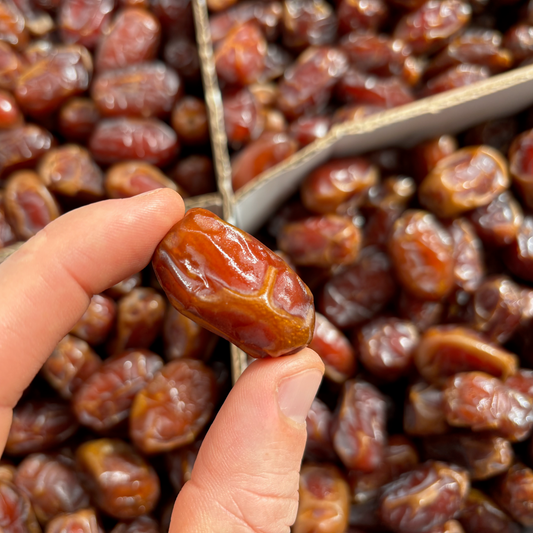fruit notes
This week’s fruitqueen box is a celebration of citrus – only appropriate for a mid-January selection of California fruit! By our count, we packed 14 varieties of citrus this week between the fruitqueen and add-on boxes. This doesn’t even begin to scratch the surface of what’s out there, but it left us marveling at the diversity of citrus varieties, and naturally curious about the origins. So we wanted to nerd out a little.
If you're ambitious, you want to dive deep, and you still have a WFH job, Genomics of the origin and evolution of Citrus(Wu et al. Nature, 2018) seems as good a place as any to start. I admit, I took a peek. Helpfully, there are pleasing full-color graphics, which mostly drowned out the whooshing sound of the science flying over my head. But for the rest of us, a simplified swing through the citrus family tree is in order.
As Joyce mentioned in fruit notes a couple weeks ago, most of the edible citrus world descends from three ancestral species: the pomelo (Citrus maxima), the mandarin (Citrus reticulata), and the citron (aka Buddha’s hand, Citrus medica). With thousands of identified varieties, this heritage lays bare the role of human intervention in the several thousand years of citrus cultivation. We’ve been busy.
Even the origins of the mandarin, which I just told you was an ancestral species, aren’t so simple. The ancestral mandarin was a bitter fruit and it required some help from the pomelo to find its sweeter form. Modern mandarins are the products of hybridization as well as introgression, the repeated back-crossing of a hybrid with one of its parents to tease out desirable traits. Among the mandarins we eat today, somewhere between a tiny and a small percentage of its DNA can be traced back to this hybridizing with pomelos.
Here’s a simplified citrus family tree, of the pomelo & mandarin side of things. Not pictured are the citron branch, which produced lemons and limes, or kumquats. On the left you can imagine the hundreds and hundreds of generations of mandarin hybrids, with some pomelo hybridization mixed in.

Years ago, I was stunned to learn that the sweet orange wasn’t the precursor to the new varieties in my expanding cognizance of citrusworld. I think this assumption was conditioned by the American grocery store of the ‘90s, where the Navel orange was a core commodity, mandarins (clementines, really) were newcomers, and pomelos were nowhere to be found. To locate the sweet orange well down the path of citrus evolution was eye-opening, one of those moments where you’re afforded a glimpse at your own ignorance (which you’re typically, you know, ignorant to).
But here too is a chance for wonder, because as much as our edible citrus varieties are the product of human intervention and ingenuity, they’re also the product of random chance.
A bud sport is a spontaneous genetic mutation where a part of a plant shows a morphological, or physical, difference. The Cara Cara orange was discovered this way: a branch of a “standard” Washington Navel orange tree, producing oranges with pink flesh, found growing in a place called the Hacienda Caracara in Venezuela.
The Washington Navel itself was a chance mutation discovered 150 years prior, in an orchard in Brazil. The variegated pink lemon, too: a bud sport of the common Eureka lemon. Imagine the astonishment, coming upon a green and white striped lemon in a field of standard yellow Eurekas, only to cut into it and reveal its pink flesh.
Sourcing is an ongoing effort and Joyce is persistent in her pursuit of the good stuff. We work with some very talented and curious farmers, even more each season. A privilege of running fruitqueen is that for me, and hopefully some of you too, citrusworld keeps expanding.
––
To fit the unconventional approach to this week’s fruit notes, we’ve included this week’s fruit with the year of their creation (or identification), in chronological order.
Kishu mandarins, Churchill Orchard, Ojai. Introduced to Japan in 1880s but its origins are 8th century in China.
Meiwa kumquats, Garcia Organic Farm, Fallbrook. 1764, Nagami (oval) x Marumi (round) kumquat hybrid.
Washington Navel orange, Rainwater Ranch, Winters. 1820, mutation of a Selecta sweet orange, Bahía, Brazil.
Minneola tangelo, Good Humus, Winters. 1931, Dancy tangerine x Duncan grapefruit hybrid, USDA Florida.
Page mandarin, Lagier Ranch, Escalon. Commonly called a mandarin but technically a tangelo! 1942, Clementine x Minneola tangelo hybrid, USDA Florida.
Cara Cara orange, Lagier Ranch, Escalon. 1976, mutation of Washington Navel, Hacienda Caracara, Venezuela.
And the odd one out – Mexican Beaumont white guava from Garcia!





